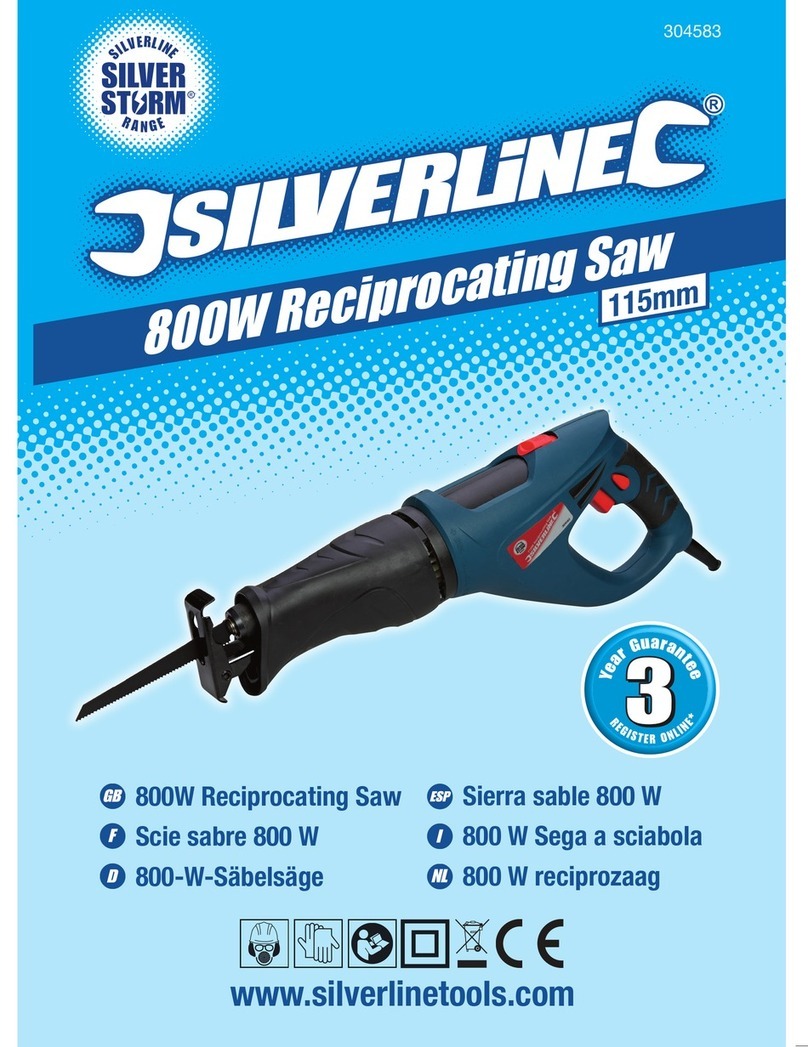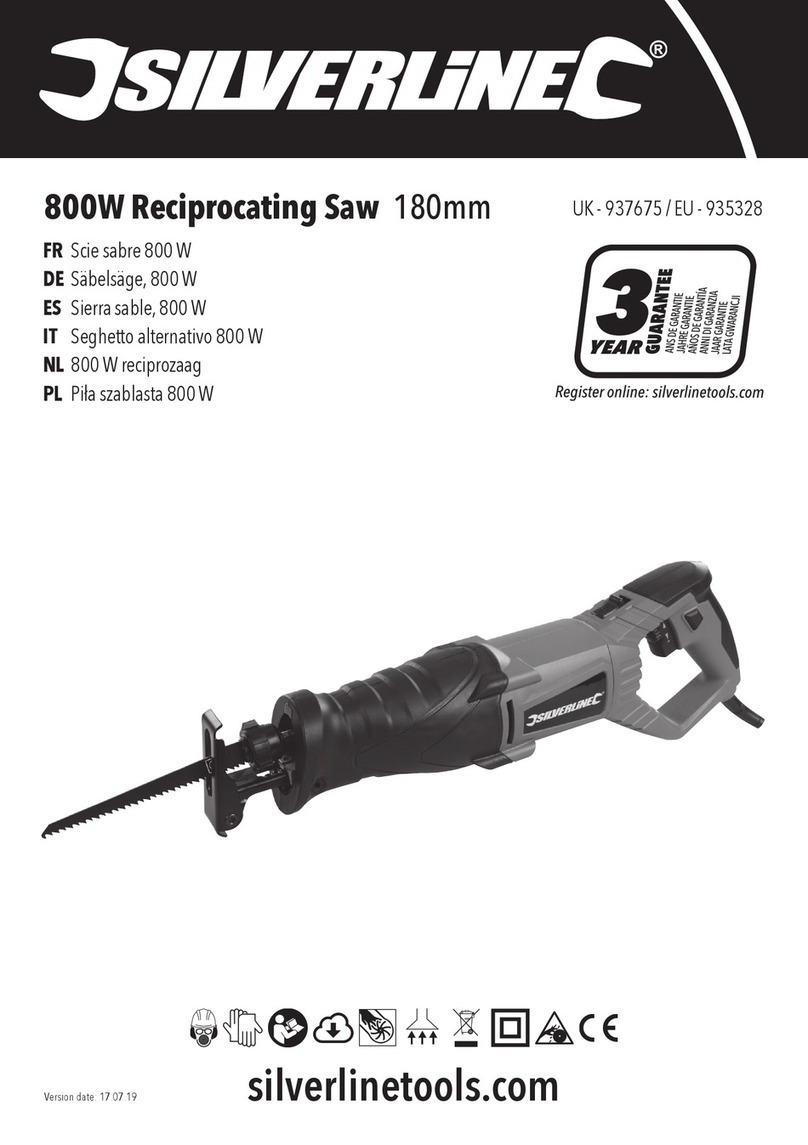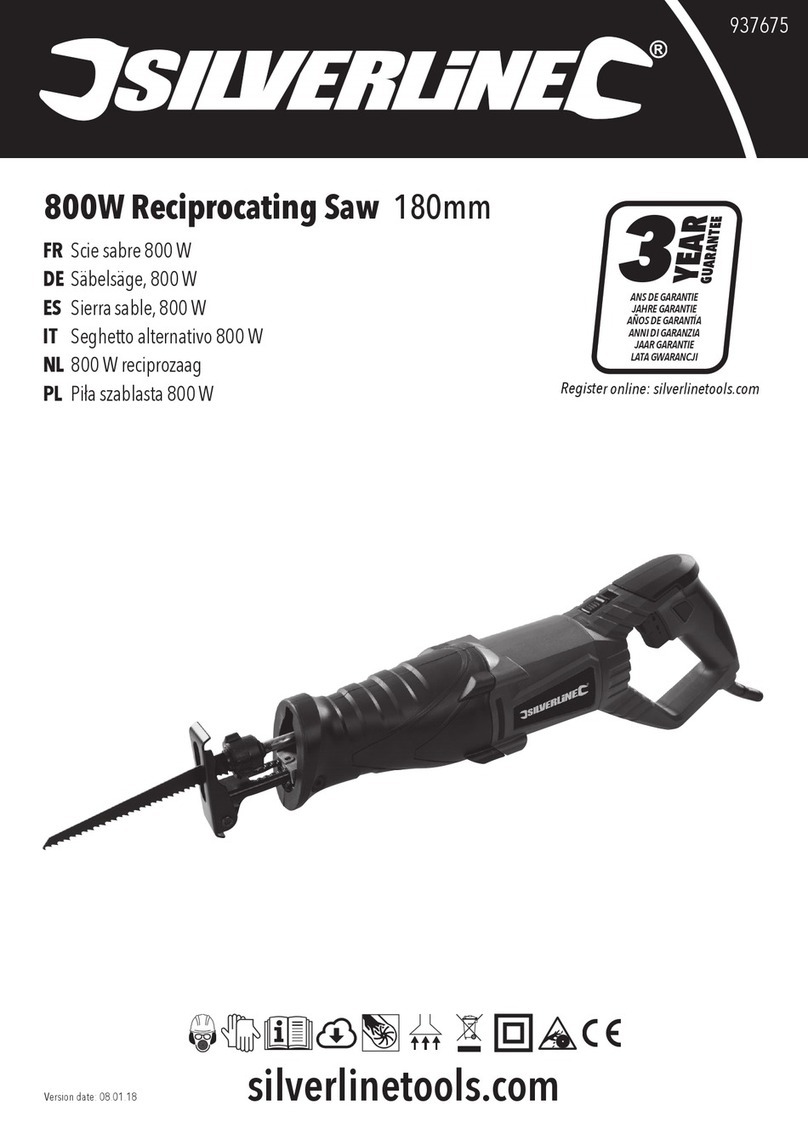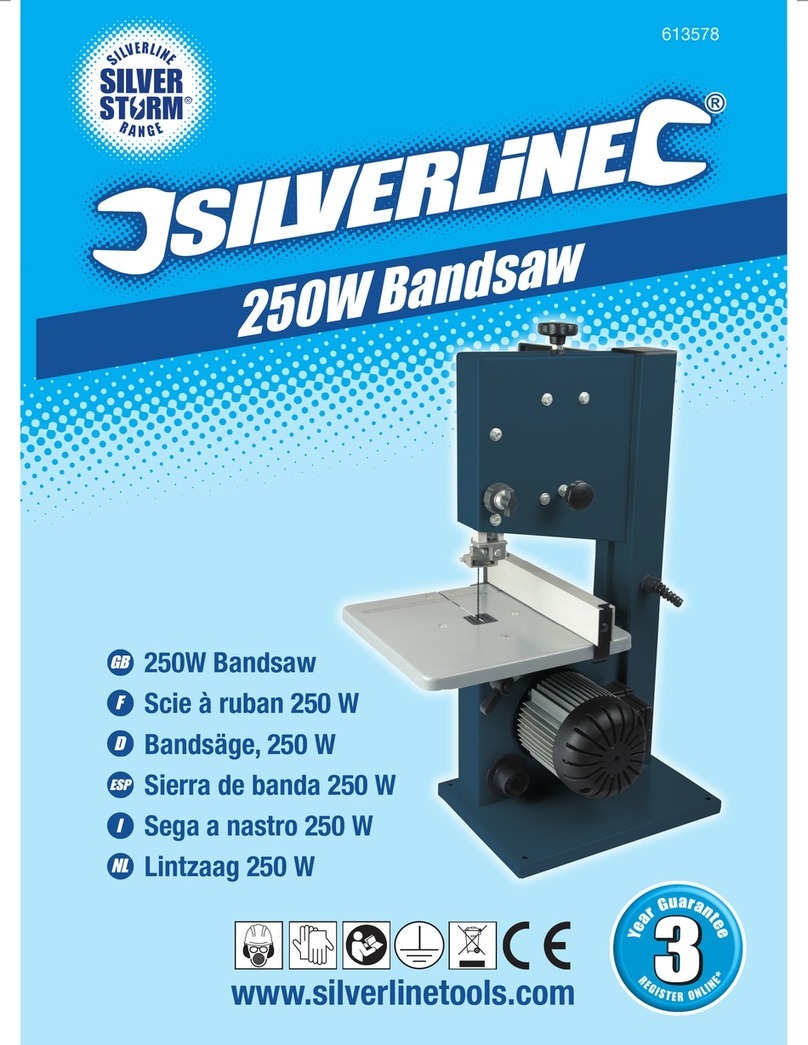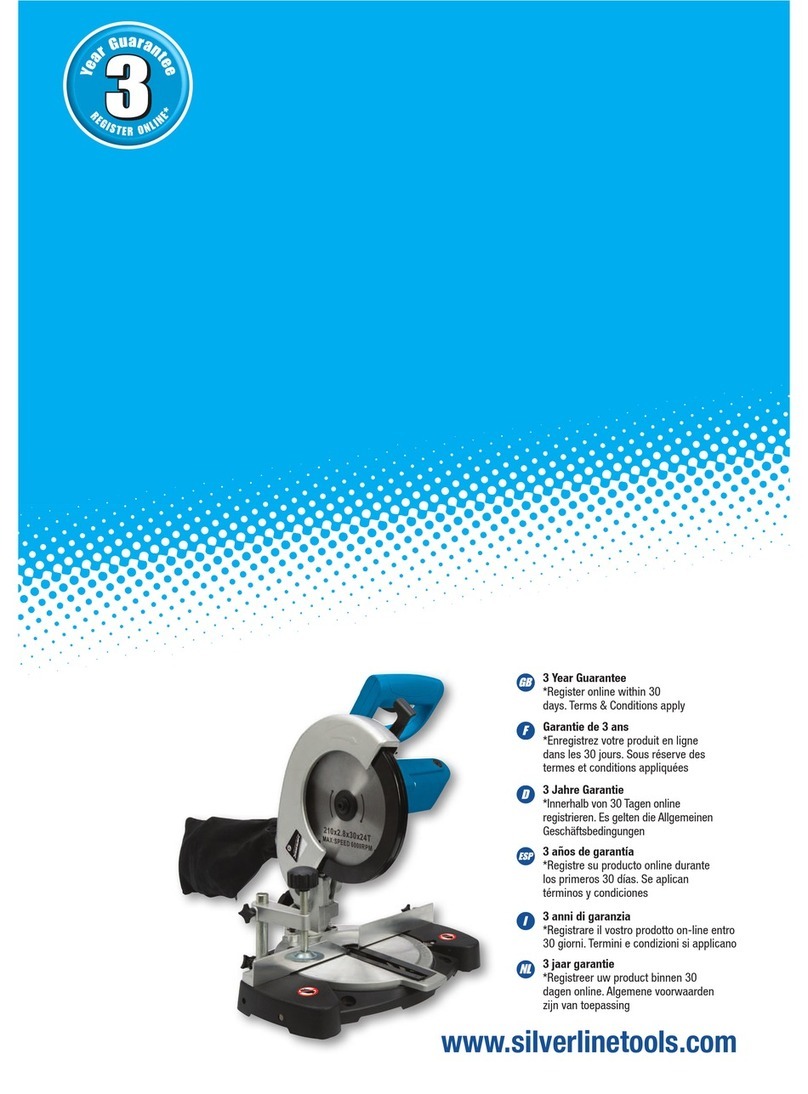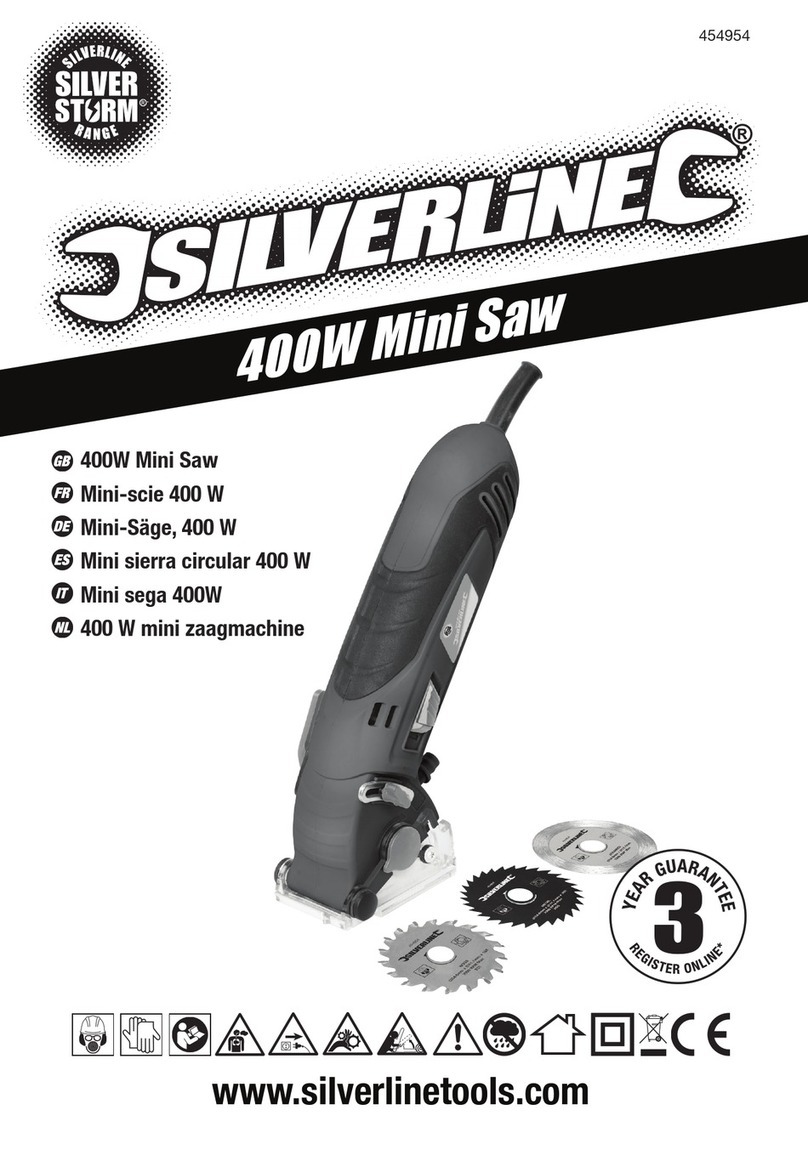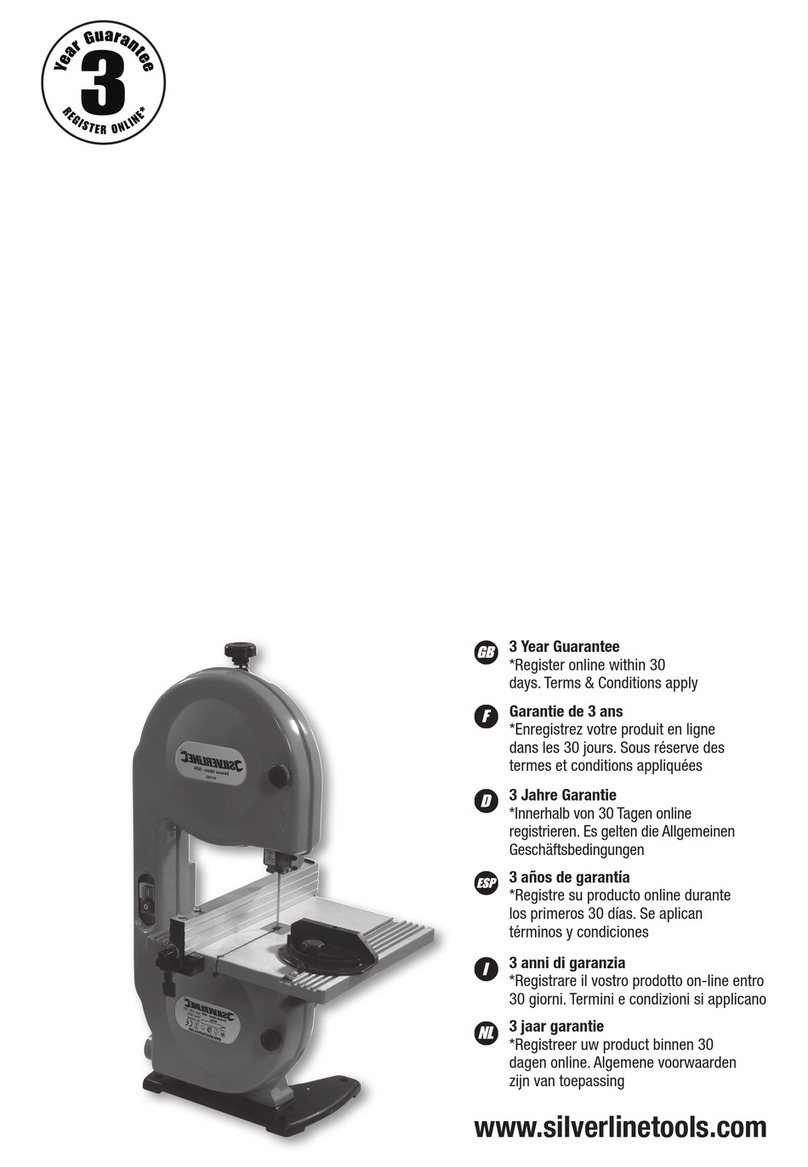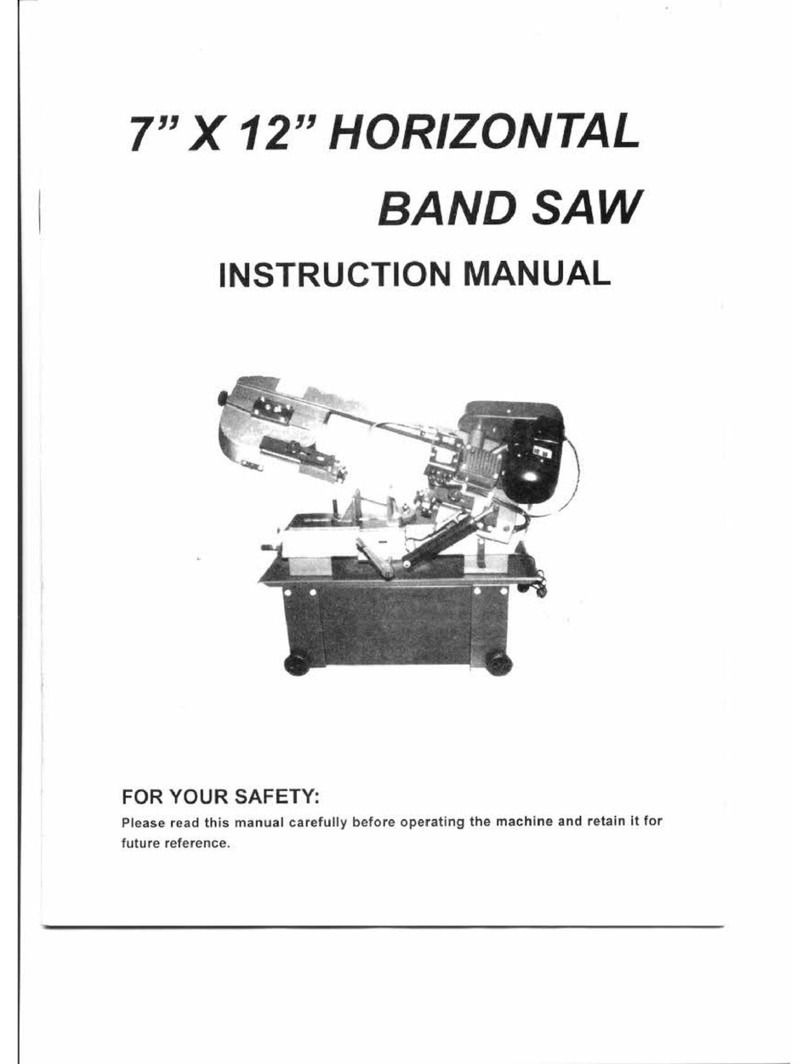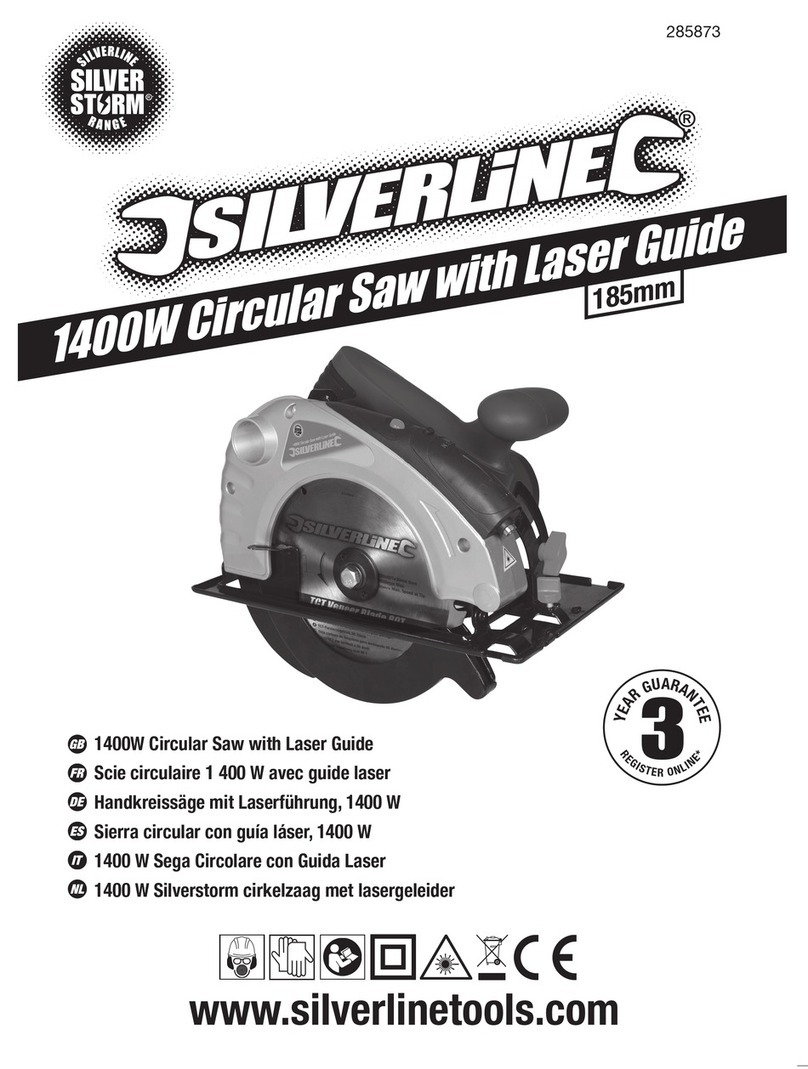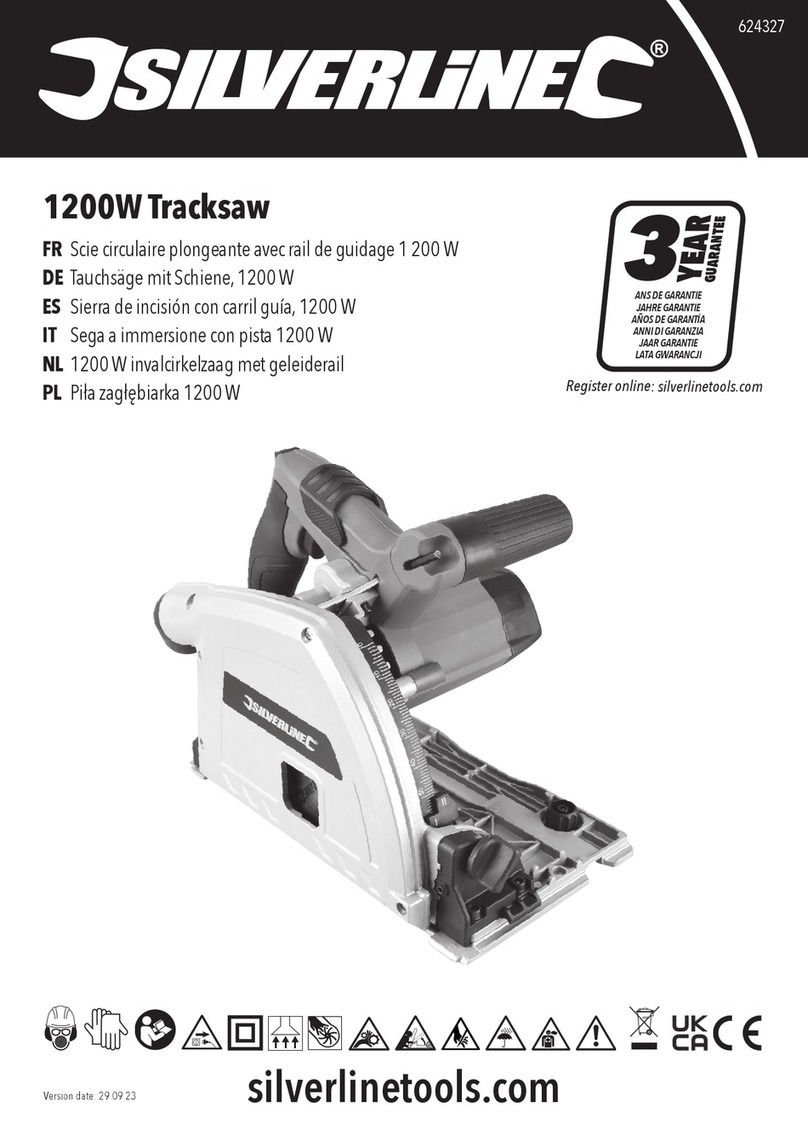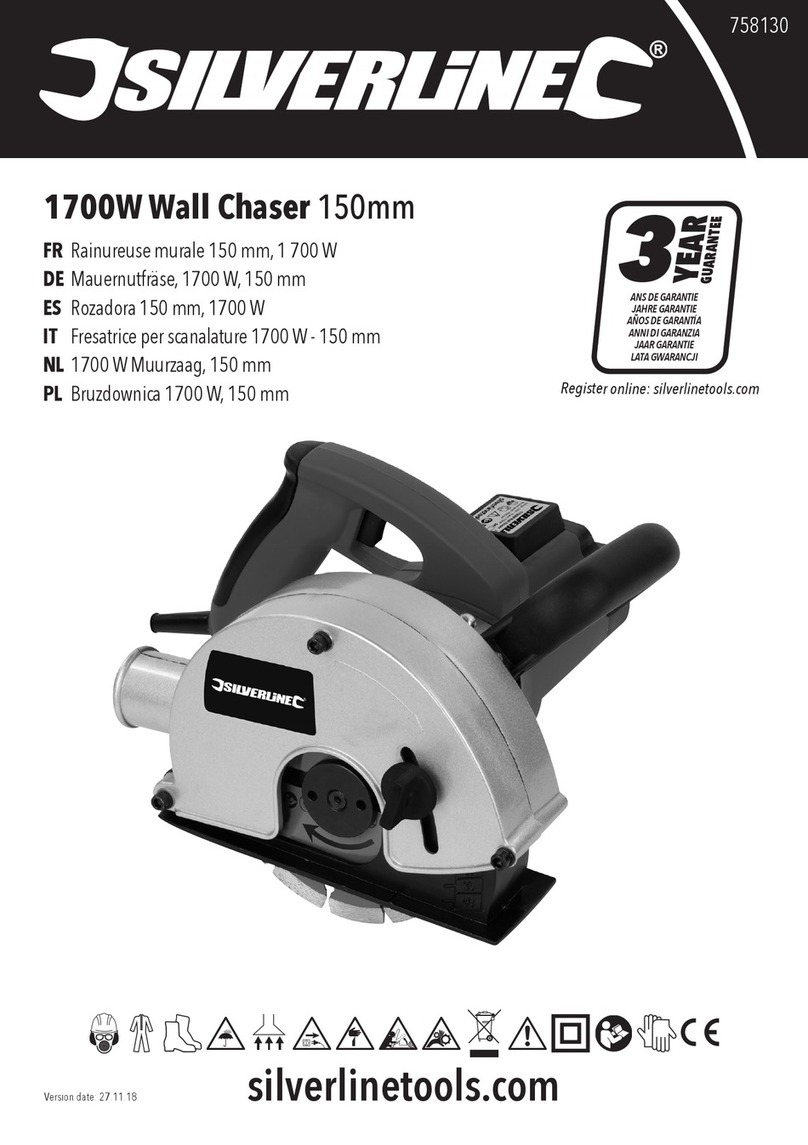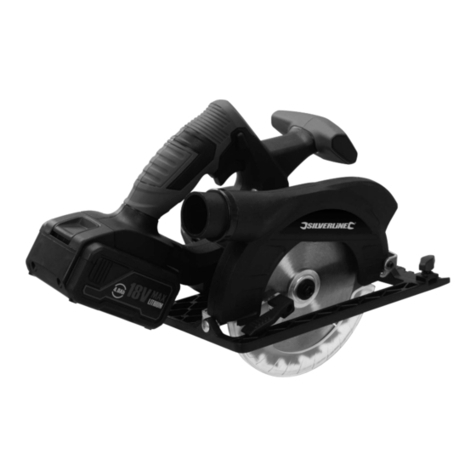
DIY 1400W Compound Mitre Saw
5
silverlinetools.com
Save all warnings and instructions for future reference.
The term “power tool” in the warnings refers to your mains-operated (corded) power tool or battery-
operated (cordless) power tool.
1) Work area safety
a) Keep work area clean and well lit.Cluttered or dark areas invite accidents.
b) Do not operate power tools in explosive atmospheres, such as in the presence of
ammable liquids, gases or dust. Power tools create sparks which may ignite the dust or
fumes.
c) Keep children and bystanders away while operating a power tool. Distractions can cause you
to lose control.
2) Electrical safety
a) Power tool plugs must match the outlet.Never modify the plug in any way. Do not use
any adapter plugs with earthed (grounded) power tools. Unmodied plugs and matching
outlets will reduce risk of electric shock.
b) Avoid body contact with earthed or grounded surfaces, such as pipes,radiators, ranges
and refrigerators. There is an increased risk of electric shock if your body is earthed or grounded.
c) Do not expose power tools to rain or wet conditions.Water entering a power tool will increase
the risk of electric shock.
d) Do not abuse the cord. Never use the cord for carrying,pulling or unplugging the power
tool. Keep cord away from heat, oil,sharp edges or moving parts. Damaged or entangled
cords increase the risk of electric shock.
e) When operating a power tool outdoors, use an extension cord suitable for outdoor use.
Use of a cord suitable for outdoor use reduces the risk of electric shock.
f) If operating a power tool in a damp location is unavoidable, use a residual current device
(RCD) protected supply.Use of an RCD reduces the risk of electric shock.
3) Personal safety
a) Stay alert, watch what you are doing and use common sense when operating a power
tool. Do not use a power tool while you are tired or under the inuence of drugs, alcohol
or medication. A moment of inattention while operating power tools may result in serious
personal injury.
b) Use personal protective equipment. Always wear eye protection. Protective equipment such
as a dust mask, non-skid safety shoes,hard hat or hearing protection used for appropriate
conditions will reduce personal injuries.
c) Prevent unintentional starting.Ensure the switch is in the OFF-position before connecting
to power source and/or battery pack, picking up or carrying the tool.Carrying power tools
with your nger on the switch or energising power tools that have the switch ON invites accidents.
d) Remove any adjusting key or wrench before turning the power tool ON. Awrench or a key
left attached to a rotating part of the power tool may result in personal injury.
e) Do not overreach. Keep proper footing and balance at all times. This enables better control
of the power tool in unexpected situations.
f) Dress properly. Do not wear loose clothing or jewellery. Keep your hair and clothing away
from moving parts. Loose clothes, jewellery or long hair can be caught in moving parts.
g) If devices are provided for the connection of dust extraction and collection facilities,
ensure these are connected and properly used. Use of dust collection can reduce dust-related
hazards.
h) Do not let familiarity gained from frequent use of tools allow you to become complacent
and ignore tool safety principles. A careless action can cause severe injury within a fraction of a
second.
4) Power tool use and care
a) Do not force the power tool. Use the correct power tool for your application.The correct
power tool will do the job better and safer at the rate for which it was designed.
b) Do not use the power tool if the switch does not turn it ON and OFF. Any power tool that
cannot be controlled with the switch is dangerous and must be repaired.
c) Disconnect the plug from the power source and/or remove the battery pack,if detachable,
from the power tool before making any adjustments, changing accessories,or storing
power tools. Such preventive safety measures reduce the risk of starting the power tool
accidentally.
d) Store idle power tools out of the reach of children and do not allow persons unfamiliar
with the power tool or these instructions to operate the power tool. Power tools are
dangerous in the hands of untrained users.
e) Maintain power tools and accessories. Check for misalignment or binding of moving
parts, breakage of parts and any other condition that may affect the power tool’s
operation. If damaged, have the power tool repaired before use. Many accidents are caused
by poorly maintained power tools.
f) Keep cutting tools sharp and clean. Properly maintained cutting tools with sharp cutting edges
are less likely to bind and are easier to control.
g) Use the power tool, accessories and tool bits,etc. in accordance with these instructions,
taking into account the working conditions and the work to be performed. Use of the power
tool for operations different from those intended could result in a hazardous situation.
h) Keep handles and grasping surfaces dry, clean and free from oil and grease. Slippery
handles and grasping surfaces do not allow for safe handling and control of the tool in
unexpected situations.
5) Service
a) Have your power tool serviced by a qualied repair person using only identical
replacement parts. This will ensure that the safety of the power tool is maintained.
Mitre Saw Safety
WARNING:Before connecting a tool to a power source (mains switch power point
receptacle, outlet, etc.) be sure that the voltage supply is the same as that specied on the
rating label of the tool. A power source with a voltage greater than that specied for the tool can
result in serious injury to the user, and damage to the tool. If in doubt, do not plug in the tool. Using
a power source with a voltage less than the nameplate rating is harmful to the motor.
WARNING!
• Hold the power tool by insulated gripping surfaces only,when performing an operation where
the cutting tool may contact its own cord. Contact with a “live” wire will also make exposed metal
parts of the power tool “live” and could give the operator electric shock.
• Always use blades with correct size and shape (diamond versus round) of arbour holes. Blades
that do not match the mounting hardware of the saw will run eccentrically,causing loss of
control.
• Never use damaged or incorrect blade washers or bolt. The blade washers and bolt were specially
designed for your saw,for optimum performance and safety of operation.
• Keep hands away from cutting area and the blade.
IMPORTANT: If you are unsure about operating this tool after reading these instructions, please
seek additional training.
a) Do not allow anyone under the age of 18 years to operate this saw
b) When operating the saw, use safety equipment including safety goggles or shield, ear
protection, dust mask and protective clothing including safety gloves
c) Power tools may produce vibration.Vibration can cause disease. Gloves may help to maintain
good blood circulation in the ngers. Hand-held tools should not be used for long periods without
a break
d) Whenever possible, use a vacuum dust extraction system to control dust/waste
e) Do not attempt to cut material thicker than detailed in the Specications section of this
manual
f) Mitre saws are not designed for general cutting of rewood. Always ensure wood is dry with
suitable at surfaces, so it is securely held on the mitre table and fence
g) Only guide the saw blade against the workpiece when the tool is switched on. Otherwise
there is a risk of kickback when the blade becomes wedged in the workpiece
h) Adjust the cutting depth to the thickness of the workpiece
i) Never remove dust, chips or waste by hand close to the blade. Ensure the tool is unpowered
and use a suitable brush
j) Only use saw blades recommended by the manufacturer that conform to EN 847-1 or
equivalent standard in your country
k) Keep rags,cloths and string away from the work area and ensure the operator’s clothing
has no loose strands of material that could become caught in the rotating blade, causing
injury. Gloves worn by the operator must not have loose strands
l) Ensure the mitre saw is operated without risk of items stored above falling onto the tool.
Vibration of the tool may cause nearby stored items to move
m) Keep saw blades not tted to the tool in a suitable container to protect against cuts -
especially when carrying
n) Always ensure the saw blade is suitable for the material being cut and that the maximum
rpm of the blade is not exceeded by the maximum no load speed of the saw
o) When using blades with a larger bore than the mitre saw spindle ensure the correct size
bore spacer (spindle ring) is used
p) When transporting the saw,ensure its own transport handle is used (not the operating
handle) and that the saw is in the locked down position
q) Do not remove cut-off material or swap the workpiece without rst returning the saw
head to the top position with the guard closed
r) Ensure work is correctly supported. Large panels may sag under their own weight and
bind the saw blade. Supports must be placed under the panel on both sides,close to the line of
cut and near the edge of the panel
s) Ensure all supports and power cables are completely clear of the cutting path
t) Always secure the workpiece to a stable platform, ensuring body exposure is minimised,
avoiding blade binding, or loss of control
u) Do not stand in line with the saw blade of the mitre saw in use. Stand to the side to avoid
possible kickback
v) Note the direction of rotation of the motor and the blade
w) Inspect the workpiece and remove all nails and other embedded objects prior to starting
work
x) Do not apply any sideways or twisting force to the blade whilst cutting
y) If a cut does not extend to the edge of the workpiece, or if the blade binds in the cut,
allow the blade to come to a complete stop and lift the saw out of the workpiece
z) Do not attempt to free a jammed blade before rst disconnecting the tool from power
1. Beware of projected waste. In some situations, waste material may be projected at speed
from the cutting tool. It is the user’s responsibility to ensure that other people in the work
area are protected from the possibility of projected waste
2. If you are interrupted when operating the saw, complete the process and switch off before
diverting your attention
3. Check the lower guard for proper closing before each use. Do not operate the saw if the
262705/977648_Manual.indd 5 01/07/2019 09:03
